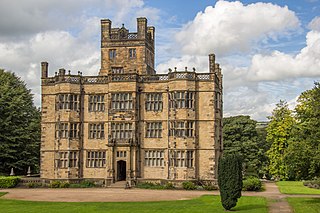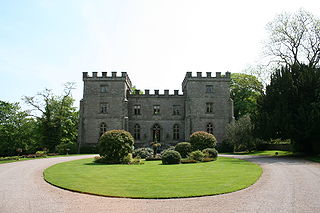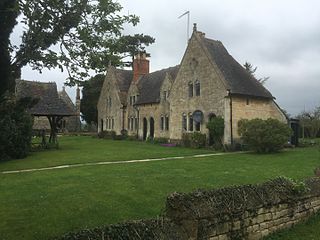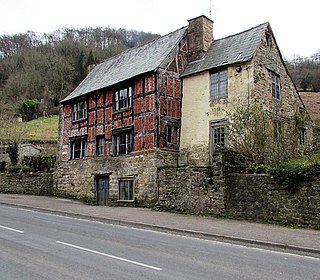
Deerhurst is a village and civil parish in Gloucestershire, England, about 2 miles (3 km) southwest of Tewkesbury. The village is on the east bank of the River Severn. The parish includes the village of Apperley and the hamlet of Deerhurst Walton. The 2011 Census recorded the parish's population as 906, the majority of whom live in Apperley.
Samuel Sanders Teulon was an English Gothic Revival architect, noted for his use of polychrome brickwork and the complex planning of his buildings.

Arlingham is a village and civil parish in the Stroud District of Gloucestershire, England. The 2021 Census recorded a parish population of 533. The parish contains the hamlets of Milton End, Overton and Priding. The next parish to the east is Fretherne with Saul.

Gawthorpe Hall is an Elizabethan country house on the banks of the River Calder, in Ightenhill, a civil parish in the Borough of Burnley, Lancashire, England. Its estate extends into Padiham, with the Stockbridge Drive entrance situated there. The house is traditionally attributed to Robert Smythson. In the mid-19th century, the hall was rebuilt by Charles Barry, the architect of the Houses of Parliament. Since 1953 it has been designated a Grade I listed building. In 1970 the 4th Lord Shuttleworth gave the hall to the National Trust, with a 99-year lease to Lancashire County Council. Both bodies jointly administer the hall and in 2015 the council provided £500,000 funding for restoration work on the south and west sides of the house.

Prescott is a settlement and civil parish in the Cotswolds within the English county of Gloucestershire. There are scattered farms and houses. There may once have been a settlement around the chapel.

Chavenage House, Beverston, Gloucestershire is a country house dating from the late 16th century. The house was built in 1576 and is constructed of Cotswold stone, with a Cotswold stone tiled roof. David Verey and Alan Brooks, in their Gloucestershire Pevsner, describe the house as "the ideal sixteenth-century Cotswold stone manor house". Chavenage is a Grade I listed building.
Thomas Paty was a British surveyor, architect and mason working mainly in Bristol. He worked with his sons John Paty and William Paty.

Clearwell Castle in Clearwell, the Forest of Dean, Gloucestershire, is a Gothic Revival house constructed from 1727. Built by Thomas Wyndham to the designs of Roger Morris, it is the earliest Georgian Gothic Revival castle in England predating better-known examples such as Strawberry Hill House by over twenty years. A home of the Wyndham family for some 150 years, the first half of the twentieth century saw a disastrous fire, and subsequent asset-stripping, which brought the castle close to ruination. Slowly restored from 1954, in the 1970s the castle housed a recording studio used by, among other major bands, Black Sabbath, Led Zeppelin, Deep Purple, Bad Company, Queen and Sweet. Now operating as a wedding venue, the castle is a Grade II* listed building.

Purton is a hamlet on the west bank of the River Severn, in the civil parish of Lydney in Gloucestershire, England. It lies opposite the village of Purton near Berkeley on the east bank of the river.

Frocester is a village and civil parish in Stroud District, Gloucestershire, England. It lies below the Cotswold escarpment, 10 miles south of Gloucester and 4 miles west of Stroud. In the 2001 census the parish had a population of 194, decreasing to 155 at the 2011 Census.
Farms for City Children is a UK registered charity which aims to provide experience of farm and countryside life for over 3,200 inner-city children per year.

Brockworth Court is a Tudor house in the village of Brockworth, Gloucestershire, England. Dating from the 16th century, it is a Grade II* listed building.

The Bee Shelter, Hartpury, Forest of Dean, Gloucestershire, England, is a 19th-century bee shelter. It is a Grade II* listed structure.

Norman Adolphus Evill FRIBA was an English architect and draughtsman, apprenticed to Edwin Lutyens.

Lechlade Manor in Lechlade, Gloucestershire, England, is a Victorian country house built for George Milward, a lawyer, by John Loughborough Pearson. Primarily an ecclesiastical architect, working on over 200 church buildings in his fifty-year career, the manor represents one of Pearson's rare forays into secular building. Dating from 1872 to 1873, Lechlade was subsequently sold to the Sisters of St Clotilde and operated as a convent for much of the 20th century. In the 1990s, it was converted back to a private residence, with some enabling development in the grounds. Lechlade Manor is a Grade II listed building.

The Church of St Mary and St Peter, Tidenham, is a parish church of the Diocese of Gloucester, England. It dates from the 13th and 14th centuries, and was extensively restored by John Norton in 1858. It is a Grade II* listed building and remains an active parish church.

The Yorke Almshouses, Nos. 14–17 Church Row, Forthampton, Gloucestershire, England, are a range of four almshouses designed by the architect William Burges in 1865. The block is a Grade II listed building and the almshouses remain private residences.
Piers Court is a country house in Stinchcombe on the Cotswold Edge in Gloucestershire, England. A Grade II* listed building, in the mid-20th century the court was home to the novelist Evelyn Waugh.

Sarah Siddons' House, also called the Old House, is a cottage in the village of Lydbrook, Gloucestershire, England. A Grade II* listed building, the cottage was reputedly the childhood home of the actor Sarah Siddons.
Overton is a hamlet in the civil parish of Arlingham, in the Stroud district, in the county of Gloucestershire, England. The name, first recorded in 1584, is of Old English origin and means "upper farmstead".. Barrow Hill (62m), above the hamlet, is the highest point on the Arlingham peninsula and offers good views across the Severn to the Forest of Dean.
















